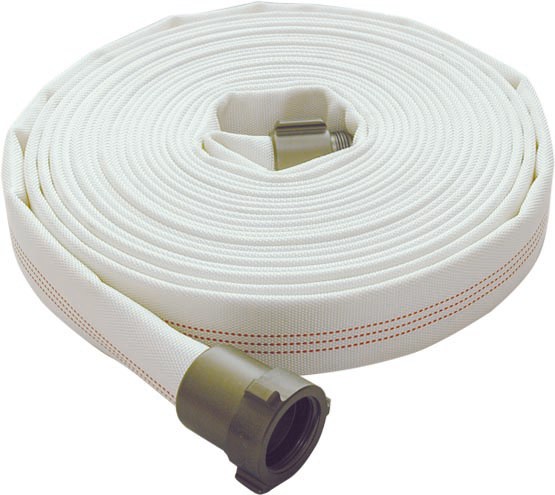NEWS
The difference between various lining fire hoses
- Categories:Technical Knowledge
- Author:
- Origin:
- Time of issue:2021-04-20 17:49
- Views:0
The difference between various lining fire hoses
(Summary description)Natural rubber-lined fire hose: It is made of high-strength synthetic fiber woven into a tubular jacket, and is lined with natural rubber. It is pressure-resistant, wear-resistant, corrosion-resistant, impermeable, low flow resistance, fast water flow, light and soft, and has a long service life.
- Categories:Technical Knowledge
- Author:
- Origin:
- Time of issue:2021-04-20 17:49
- Views:0
Natural rubber-lined fire hose: It is made of high-strength synthetic fiber woven into a tubular jacket, and is lined with natural rubber. It is pressure-resistant, wear-resistant, corrosion-resistant, impermeable, low flow resistance, fast water flow, light and soft, and has a long service life. It can be matched with fire hydrants and fire pumps (vehicles) to transport water or other fire extinguishing agents. It can also be widely used in industrial and mining, shipping, petrochemical, agricultural and other fields.
Natural rubber hose liner is soft, it can remain soft in low temperature environment, easy to use, rubber material can withstand a certain temperature of liquid
Double-sided nitrile glue tape: Using high-strength synthetic fiber (high-quality polyester filament) as raw material, it is woven into a tubular jacket. The one-time forming method is to extrude nitrile rubber from the outside of the tube blank through an extruder and penetrate into the inside to form A whole sandwich structure is then vulcanized. The inner and outer nitrile rubber and the fabric are bonded without using any glue, and have very good adhesion. The two-step method is also called the lining method, which is lining the nitrile rubber and then turning the inner lining rubber to the The outside, and then the inside wall is lined with nitrile rubber again and vulcanized. The one-time forming double-sided nitrile rubber fire hose is the golden spire of the hose. This production process has been monopolized by foreign countries. In recent years, only a handful of domestic manufacturers have mastered the production process of this product. The product has the characteristics of softness, heat resistance, pressure resistance, oil resistance, abrasion resistance, chemical corrosion resistance, low water flow resistance, fast water flow, good weather resistance, and long service life. It can be matched with fire hydrants, fire pumps (vehicles), and transport water. , Oil or other fire extinguishing agents, can also be widely used in industrial and mining, shipping, petrochemical, agricultural and other fields.
PVC hose structure: The outer layer of the hose is woven from polyester yarn and polyester yarn, and the lining is pvc.
Product features: high pressure resistance, durability and no leakage.
Product use: widely used in fire fighting, water supply or transportation of other liquids. It is a supporting product for fire hydrants, fire trucks, and fire pumps; it is a necessary fire fighting equipment for hotels, office buildings, airports, stations, warehouses and other places.
Pvc is mainly characterized by good economy and strong applicability. It can meet customer requirements by adopting different formulas according to the different places of use. It is currently the mainstream hose in the domestic market.
polyurethane fire hose:
The product has excellent overall performance and has many valuable properties from rubber to plastic. The first is high strength, and its tear strength is about 3 times that of natural rubber; the second is good abrasion resistance, which is about 3 times that of nitrile rubber; the third is good oil resistance, and its affinity with non-mineral oils is low. The fuel oil is hardly corroded; fourth, it has good weather resistance and can maintain its original performance after long-term storage; fifth, it has good low temperature resistance and does not embrittle at low temperatures of -20°C to -50°C. The polyurethane-lined fire hose produced with imported equipment and imported raw materials, in addition to most of the advantages of rubber hoses, also has excellent high pressure resistance, oil resistance, weather resistance, corrosion resistance, bending resistance, etc., and it is light in weight and easy to use. Soft and convenient, the weight per unit length is more than 40% lighter than the rubber-lined hose. It is a new generation product that reduces the fighting strength of the firefighting force and improves the fire-fighting performance. It is favored by users. This product has long become a mainstream fire hose in developed countries such as Japan, Europe and the United States, and is even used by the public as an ordinary water pipe for washing flowers and plants. In our country, because of the high cost of raw materials and high prices, most of the equipment was imported, and it was not promoted until the late 1990s. At present, most firefighting forces have begun to equip polyurethane fire hoses, and many industrial and mining enterprises, petrochemical oil depots, ship terminals, and high-end buildings have begun to use them in large quantities.
The fire hose is made of high-strength synthetic chemical fiber as the woven rubber as the lining, and the two are tightly combined under the action of high pressure. It is an ideal matching product for fire-fighting equipment. It can also be widely used in shipping, petrochemical, water conservancy, greening and other fields.

Scan the QR code to read on your phone
Nantong Sentian Fire-Fighting Equipment Co.,Ltd.
Service Hotline:
Address:
No.10, Yangsha Road,Qidong City,Jiangsu,China.
Copyright © 2021 Nantong Sentian Fire-Fighting Equipment Co.,Ltd. 苏ICP备17053518号



